| Review and compare selected herb gardening books. |
| ABOUT US START IDEAS DO LESS USEFUL PLANTS PROJECTS VIEWS RESOURCES TOPICS |
|
|
|||
| BOOK REVIEWS |
|
||
|
Barnes and Noble recently (2003) issued Garden Herbs as one of their Gardeners Handbooks series. It has 45 pages on growing herbs, including a couple on garden design, 30 pages on maintenance, 20 pages on harvesting and use, and a 200-page plant directory with one page for each herb including guidelines for growing, harvesting, companion planting, and uses. I found myself paging through the plant directory, noting down (when some plant struck my fancy) the plant and possible placement. The other information in the book was very basic and covered general overviews of key information about soil, climate, biology, etc, which would all be useful to the beginning gardener. I liked the focus on natural, organic methods of disease prevention and control, including a section on interplanting with beneficial plants and companion planting. This wasn't a hugely exciting book, but it provided good basic information for $7.98. RETURN to Herb Garden Book Reviews |
[sorry, no purchase info for this book] | ||
|
The Herb Garden by Sarah Garland (Penguin Books, first published in 1984 but revised in 1996) is enthusiastic and inventive, just the type of resource I was hoping to find. She says in the introduction, "I have always found great comfort in a sense of the continuity of history; not the history of battles, kings and queens, but the lives of ordinary men and women, their preoccupations and beliefs, their domestic chores, their food and their gardens." This book not only gives an interesting account of how herb gardens (both their designs and their plants) have evolved through history, but also gives specific examples of styles (wild garden, knot garden, etc.) with color photos of different gardens in each style and a discussion of how to design and what plants to use for each style. This is an inspirational book that gets the ideas and plans flowing, but it is also helpful at narrowing down which plants and style go together, and therefore, which kind of design you might like best. Garland's lyrical language is a bonus and helped pull me through the dense information-packed paragraphs. The photos and planting diagrams are gorgeous too. Another thing I like is the discussions of herbs for various categories of use—for an evening scented garden, for culinary use, etc.—and their special requirements. As if that all weren't enough valuable information for one book, there's a section on constructing herb gardens that treats boundaries (living and nonliving), floors, and seating (also living and nonliving). There are also a few lists of herbs for this or that situation, general information on cultivation and harvesting, and a directory with very brief descriptions of cultivation and use (but no hardiness zone information, something we northerners like to know). All in all, this book is a great bargain and not too large - 160 pages for $19.95. RETURN to Herb Garden Book Reviews |
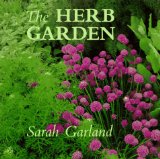
The Herb Garden at Amazon.com | ||
|
Rodale's successful Organic Gardening: Herbs Rodale's successful Organic Gardening: Herbs, by Patricia S. Michalak, begins with brief basic information on climate, soil, and plant biology, then supplies a handy chart of all the herbs mentioned (several pages long) with zone, form, size, environmental conditions, propagation techniques, usage, description, and pests/diseases. The cultivation advice covers basic organic gardening techniques such as using compost and mulch to build soil and cover crops to keep weeds down. It advocates double-digging, which makes the gardener do the work instead of letting good soil build itself over several months by smothering. The book also touches on propagation and insect control and identification, and it includes a few recipes for herb butters and such and instructions for crafts like wreaths, dyeing, and soaps. The last half of the book consists of a directory of herbs with one column of text per herb. Overall, this is a good introduction to organic herb gardening with enough information about techniques to help a beginner plant and maintain a garden. Basic plant-specific information is provided, just as it is in the Barnes and Noble book mentioned earlier. There's not much design help in either of these, so they didn't fulfill my needs as well as some of the others in this list. RETURN to Herb Garden Book Reviews |
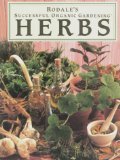
Herbs at Amazon.com | ||
|
One book that I used when making my list of which herbs to plant is The Butterfly Book by Donald and Lillian Stokes and Ernest Williams. I wanted to plant larval foods to get butterflies to lay eggs in my garden, and I also want nectar sources for the grownup butterflies. This book has maps showing the range of each butterfly it discusses. I used the maps to figure out which species I have a hope of attracting. Then I read the section on "How to Attract" which includes nectar sources, general landscaping, and larval foods for that species. When I notice caterpillars in the garden, I can look them up in the handy photo directory of caterpillars. The book treats 15 groups of butterflies, not too overwhelming a number, plus it's short (less than 100 pages) and has pretty color photos. It's also relatively inexpensive ($11.95 from Little, Brown, published in 1991). Of course this information is probably out on the net somewhere (except perhaps for the caterpillar directory), but I like small books full of useful information. I find them so convenient. RETURN to Herb Garden Book Reviews |
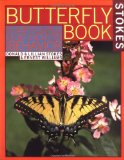
Butterfly Book at Amazon.com | ||
|
Herbs in the Garden: The Art of Intermingling Here's a book that addresses the ornamental qualities of herbs within the context of garden design. It's Rob Proctor and David Macke's Herbs in the Garden: The Art of Intermingling. What an alluring title. I think I actually paid full price for the hardcover version ($29.95 from Interweave Press, copyright 1997). Chatty, clever, personal, and adventurous, this is one book that won't caution you to wait a year to watch where the sun hits or plan the entire landscape before you plant anything. The book is built around the idea of foliage as the architecture of an interesting garden, and herbs as prime candidates to supply that foliage. The herbs are mixed in with other garden plants. The authors write: "Because different herbs have different cultural requirements, we decided to intermingle them with plants that share their needs." Drought tolerance is a big issue in the book; the authors live in Denver, and several of the other featured gardens are located in arid climates of the Western and Southwestern United States. Other organic tenets also dominate; these guys believe in packing their plants together and not supplying extra fertilizer or water. The text includes descriptions of various cultivars and species, with helpful advice about growth habits and cultivation and lots of discussion of ornamental species of herb to try in different habitats. Proctor and Macke offer some design pointers, but also a liberal dose of encouragement to experiment and trust your own taste. "What textural advice boils down to is this: put the big-leaved plants near the little-leaved plants, and put the spiky plants with the roundy-moundy plants. And don't forget to put the fuqqy things with the shiny things." This sentence is a perfect example of the authors' writing style and approach to gardening. Their enthusiasm is contagious. Reading the book made me want to dash out and buy all kinds of seeds and seedlings and plant them all over the place in densely packed beds. At the back is a table with bloom time and color, height, zone, and notes on culture for every herb discussed in the text. This is truly a gem of a book. RETURN to Herb Garden Book Reviews |
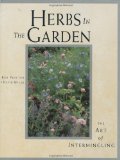
Herbs in the Garden at Amazon.com | ||
|
Herbal Tea Gardens: 22 Plans for Your Enjoyment and Well-Being My main use for plants, particularly herbs, is making tea from them. Naturally, I was excited to find a book called Herbal Tea Gardens: 22 Plans for Your Enjoyment and Well-Being. Author Marietta Marshall Marcin (what a tongue-twisting name for an author) provides a great plant directory that includes instructions about how to grow and use nearly 100 plants, and along with every entry is a tea recipe that includes the plant. Marcin includes cautions about the plants that many herb gardening references do not. These cautions are useful if you're actually planning to ingest or touch the herbs. However, some typos (i.e. plant names transposed) led me to be cautious about what I read in this book, so I'd double-check with a more reliable source before following any health-related advice from this book. That said, Marcin offers many creative ideas for garden designs, based on either the function of the plants (i.e. Eye Care Garden) or landscape needs (Shade Garden). There's also a useful section on how to make harbal teas, along with general instructions for growing, planting, and harvesting herbs. Finally, there's a quick reference chart of all the herbs mentioned with their growing conditions at a glance. For someone who doesn't know much about gardening but wants to grow herbs for teas, this is a terrific reference with everything they'll need (except they should double-check the medical/health uses of the plants with a more reliable source). RETURN to Herb Garden Book Reviews |
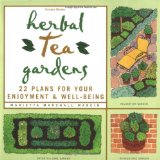
Herbal Tea Gardens at Amazon.com | ||
|
The Kitchen Garden Planner, by Darrell Trout, presents luscious close-up color photos of herbs and vegies. If you like glossy magazine articles full of visual appeal, you might enjoy reading this book. If you want logically arranged, in-depth information, the 5-column-per-page format and the large colored headings breaking up the text might drive you crazy. Unfortunately, the writing doesn't flow well and tends toward vague, sentimental wording, but on the other hand, the pictures are gorgeous - covering flowers as well as vegies, fruits, and herbs. So are the garden diagrams. The book highlights thirteen gardens around the U.S., most of them located along the eastern seaboard, with a couple in Washington state and a couple in the Midwest. Every garden is described with a page of text and roughly four pages of photos. A plant or two is highlighted within the text of each garden. Each page also has a short blurb on some aspect of gardening - a spotlight on one plant or style or technique. Later sections address cultivation of some popular kitchen garden plants in more detail - tomatoes, lettuce and other greens, fruit trees, and edible flowers. For each of these categories of plant, Trout describes the different types available (for instance, cherry tomatoes, roma tomatoes, and large beefsteak tomatoes) and compares some popular cultivars. This book tends to offer tidbits of information rather than complete, organized blocks of it. There are several gaps you'd proably want to fill with another information source. Photos don't show the whole plant, or habit , so you don't get a feel for the plant's architectural contribution to an area. All flowers are magnified to the same size, so their relative size information is lost too. Though it's not very useful as a design or planting reference, this book does offer a pretty and light read. It might be just right for someone who doesn't want to be submerged in detail but merely wants to be inspired by appealing photos of food plants. Or for someone who wants to dream about kitchen gardens rather than actually making one. RETURN to Herb Garden Book Reviews |
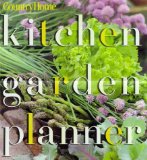
Kitchen Garden Planner at Amazon.com | ||
|
Now for something completely different. Paul Seitz's The Complete Herb Gardener is brief but fact-filled. It contains more scientific information than the others mentioned - for instance, Seitz describes spontaneous versus contact-initiated fragrance, gives instructions for biological ways to prevent plant disease (herbal teas for your plants, companion planting, soil building), and discusses how much to water for optimum plant health. The book also contains several designs with diagrams and plant recommendations. These designs were more appealing to me than many I'd seen because they seemed more sensually satisfying and easier to maintain. For instance, the "sunken garden of aromatic herbs" is just a standard rectangle divided into four equal-sized beds, but it consists of two perennial herb beds, one annual herb bed, and one low thyme lawn edged with lavendar in which the gardener's lounge chair lives. Seitz provides specific examples of many things that could be done - plant-wise and structure-wise - around the edges of the garden, so that there are many features in the plan, many focal points, and a lot of year-round interest due to the focus on structure. Yet the layout would be simple to build and, with the perennials and annuals separated, easier to maintain. Also this was the only book of the ten that shows a spiral garden design, useful for creating different microclimates in a small space. Other ingenious ideas include growing herbs on balconies in plastic-lined burlap sacks. Unlike Trout's book, Seitz's plant directory includes color photos that show the habit of most plants rather than close-ups of flowers. Each plant's profile includes information about well-suited companion plants. The end of the book covers how to store herbs, make tinctures and wines, potpourri, herb pillows, and all manner of other uses for herbs. For a little (140-page) book, this packs a powerful punch. RETURN to Herb Garden Book Reviews |
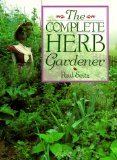
The Complete Herb Gardener at Amazon.com | ||
|
Gardening with Herbs is a well-chosen title for this book by Emelie Tolley and Chris Mead, because it treats gardens with special attention to herbs. The authors proflie twenty-five gardens in the U.S. and Europe, most of which are large estates. The gardens have herbs in them but aren't solely devoted to herbs. Like the Kitchen Garden book, this one devotes about one page of text and four of photos to each garden. The text is intelligent and informative, though there isn't much of it, and mainly describes the layout of each garden with tidbits about its history or unique aspects. It is liberally sprinkled with the advice or thoughts (in their own words) of the gardeners who are profiled. The garden profiles are interspersed with sections devoted to style issues such as topiary, plants for the garden floor, edging, or decorative features. Selected photos from different garden profiles are duplicated and used as examples within the discussion of each style issue. This book is mainly of interest as a virtual garden tour to get the ideas flowing. It doesn't provide any basic instructions for growing herbs or designing an herb garden. RETURN to Herb Garden Book Reviews |
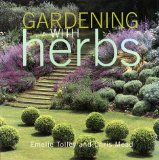
Gardening with Herbs at Amazon.com | ||
|
Landscaping with Herbs by James Adams gives a good overview of six different styles of herb garden, with detailed discussions of a half-dozen key herbs that would fit well within each style of garden and also a diagram and verbal "walk-through" for a sample garden in each style. Many recipes and other uses for the herbs dot the text. Discussions of herbs include comparisons of varieties and cultivars, and often of similar species as well. Design tips describe how to replicate or echo particular wild/natural environmental features. For example, the discussion of wormwood advises letting it intermingle with widely spaced fir and spruce trees to replicate the mountain forests of the Northwest. Most of the book is text. Drawings and diagrams are in black and white, and the few color photos are not notable for their quality or interest. However, the text includes information that none of the other books in my list provided, such as the specific chemicals that produce the scent of many herb species (Adams is a chemist). Furthermore, it is dense with ideas and practical descriptions of the plants that cover scent, color, form, uses, combinations, and growing requirements. This book taught me the most about each plant. It also mentions the most plants, over 650 varieties. Plants are not arranged in easy directories, because the plant-specific information is imparted within the text rather than separated into tables, but Adams includes an index for relatively easy access to plant-specific information. He includes a couple of nice reference tables at the back of the book, one that presents information on habit, propagation, and cultivation of all herbs discussed, and the other with landscape and herbal uses for all herbs discussed, as well as plant origins where known. The author's breadth of knowledge and loosely organized style reminded me of Euell Gibbons (author of Stalking the Wild Asparagus and other fascinating books about wild plants). Adams provides the best landscaping advice of the ten books I've covered, presenting multiple options for overall style plus multiple options for using each of the herbs treated. But this book is a longer read and requires more patience to wade through than the others, so Sarah Garland's book might be more appropriate for readers short on time who want herb garden design ideas. RETURN to Herb Garden Book Reviews |
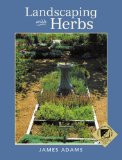 Landscaping with Herbs at Amazon.com | ||
|
Whew! That's it for the comparative review. I hope you will be able to use my observations to find the information you want, whether you choose from the books mentioned above or discover others to help you. The important thing is to plant (or eat, or just ponder) some herbs! |
|||
|
Thanks for visiting http://www.LessLawn.com! All site contents © 2001-2013 Evelyn J. Hadden, except where noted. All rights reserved. |